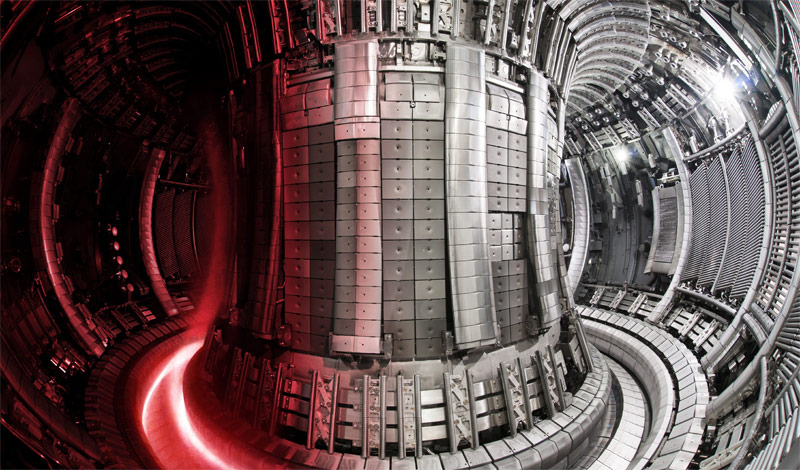
9th February 2022
Major breakthrough in fusion energy
The biggest breakthrough in fusion energy since 1997 has been reported today at the Joint European Torus in Oxford, UK, with 59 megajoules produced over five seconds (11 megawatts of power), more than double the previous record.
The results announced today from the Joint European Torus (JET) are the clearest demonstration in 25 years of the potential for fusion energy to deliver safe and sustainable low-carbon energy.
Researchers from the EUROfusion consortium – 4,800 experts, students, and staff from across Europe, co-funded by the European Commission – used the JET to release a record 59 megajoules (MJ) of sustained fusion energy.
This achievement, in the world’s largest and most powerful operational tokamak, at the UK Atomic Energy Authority (UKAEA) site in Oxford, more than doubles the previous fusion energy record of 21.7 MJ set there in 1997. It comes as part of a dedicated experimental campaign by EUROfusion to test over two decades’ worth of advances in fusion and to optimally prepare for the start of the international ITER project.

The Joint European Torus at Oxford, UK.
Fusion, the process that powers stars like our Sun, promises an inherently safe, near-limitless clean electricity source for the long term, using small amounts of fuel that can be sourced worldwide from inexpensive materials. It brings together atoms of light elements like hydrogen at ultra-high temperatures to form helium and release tremendous energy as heat, which can then be converted into electricity.
The JET fusion experiment – which creates plasma reaching temperatures of 150 million degrees Celsius, 10 times hotter than the centre of the Sun – is a vital test bed for ITER, one of the biggest collaborative science projects in history. JET can reach conditions similar to those in ITER and other future fusion plants and is the only operational tokamak in the world that can use the same deuterium-tritium (D-T) fuel mix planned for those devices.
“Our experiment showed for the first time that it’s possible to have a sustained fusion process using exactly the same fuel mix planned for future fusion plants,” Tony Donné, CEO of EUROfusion, said at a press conference.
No materials exist that can withstand direct contact with such heat. So, to achieve fusion in the machine, scientists contain the plasma inside an extremely powerful magnetic field, shaped like a doughnut. Previously, JET had used carbon, but carbon absorbs tritium, which is radioactive. So, for their latest tests, scientists developed new walls, constructed from the metals beryllium and tungsten. These are 10 times less absorbent. They then configured their plasma to work effectively in this new environment.

Exterior view of the JET tokamak. Credit: EUROfusion
“This achievement is the result of years-long preparation by the EUROfusion team of researchers across Europe,” said Donné. “The record, and more importantly the things we’ve learned about fusion under these conditions and how it fully confirms our predictions, show that we are on the right path to a future world of fusion energy. If we can maintain fusion for five seconds, we can do it for five minutes and then five hours as we scale up our operations in future machines.
“This is a big moment for every one of us and the entire fusion community. Crucially, the operational experience we’ve gained under realistic conditions gives us great confidence for the next stage of experiments at ITER and the demonstration power plant EU DEMO, which is being designed to put electricity on the grid.”
Mark Wenman, a nuclear materials researcher from Imperial College London, said in a statement that the experiment’s results are “exciting,” and show that “fusion energy really is no longer just a dream of the far future – the engineering to make it a useful, clean power source is achievable and happening now.”
Following this milestone, JET is likely to be decommissioned by 2023-24. The ITER project is now 80% built and scheduled for operation by 2025. Its toroidal vessel volume will be 10 times that of JET.
In the future, large commercial fusion plants are expected to require only 400 kg per year of deuterium and tritium fuel – ten million times less than the amount of fossil fuels used to generate the same amount of electricity.
—
• Follow us on Facebook
• Follow us on Instagram
• Join us on Reddit
• Follow us on Twitter
• Subscribe to us on YouTube
Comments »